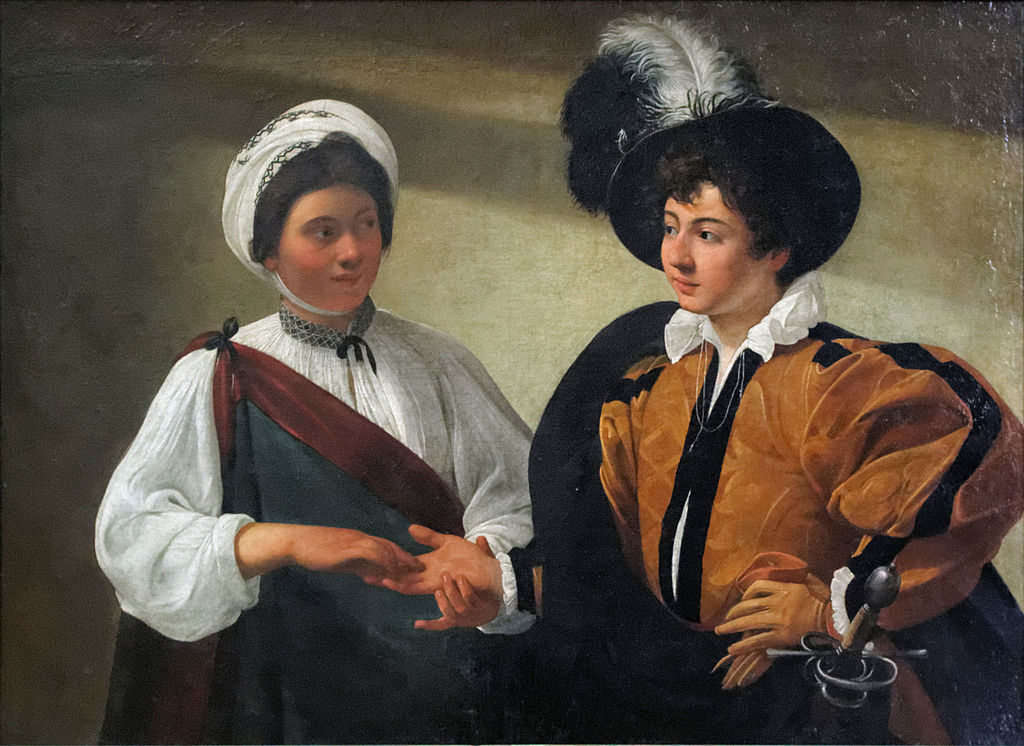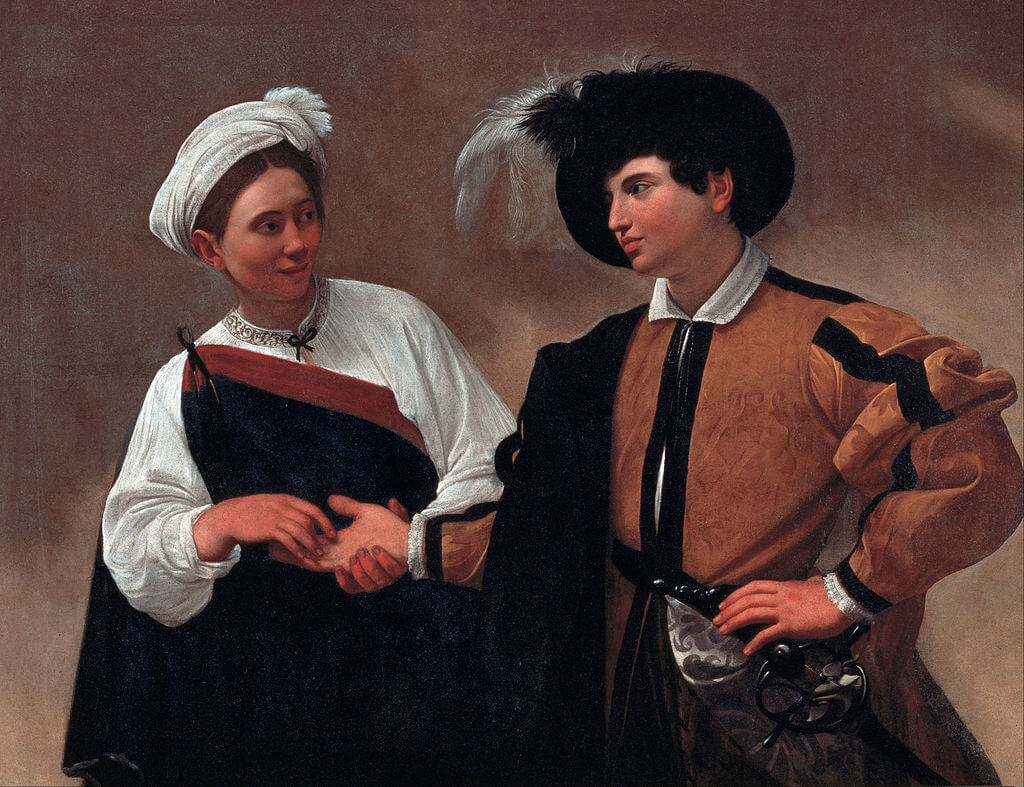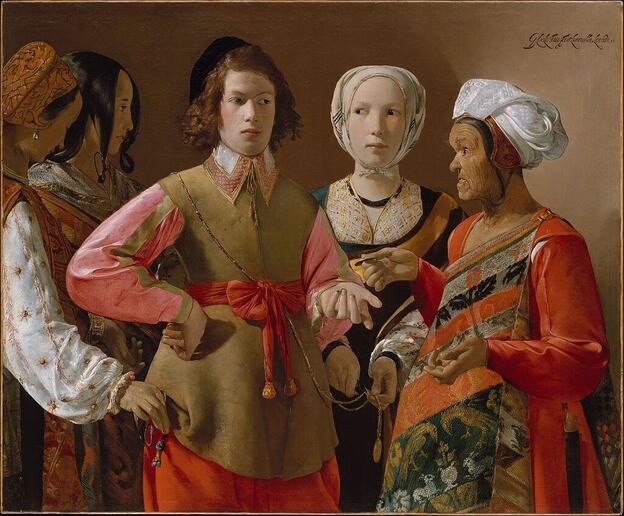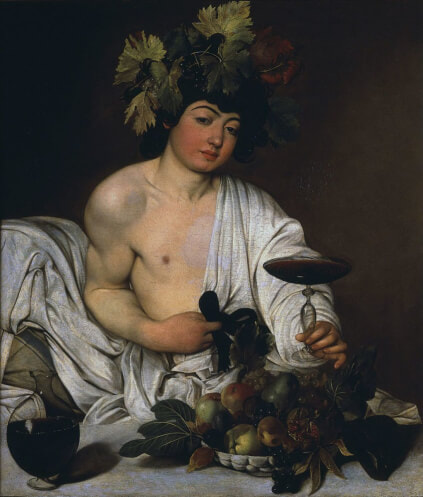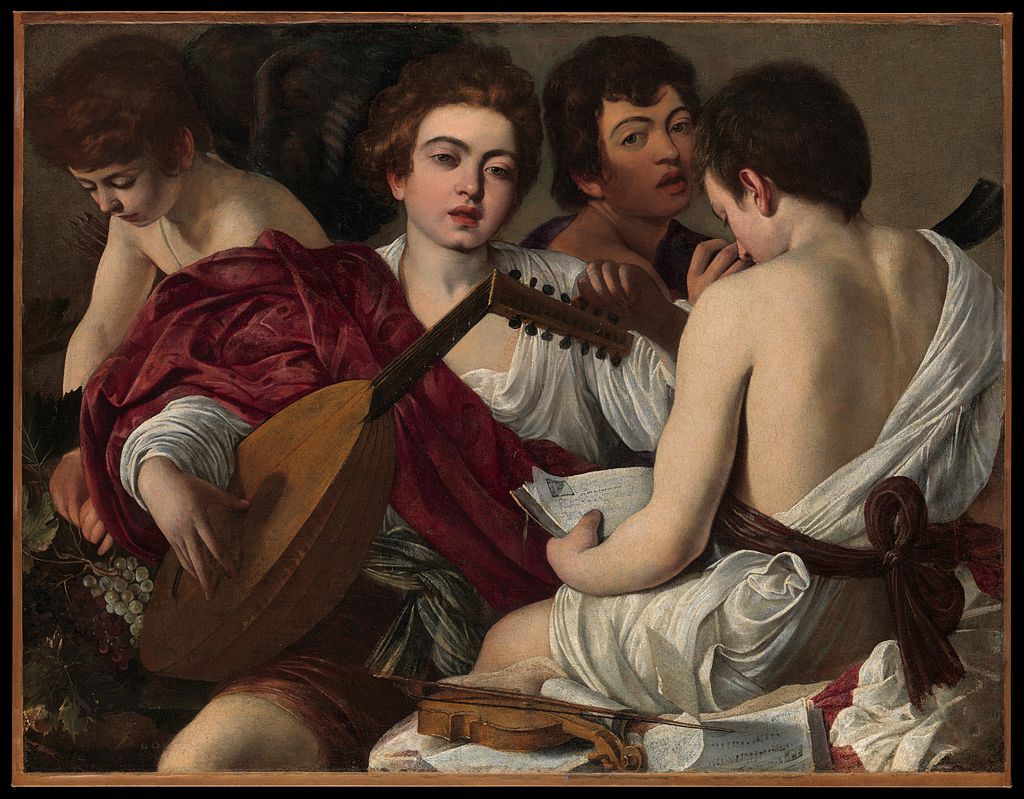|
Where? First floor, room 712 of the Denon wing in the Louvre
When? Between 1595 and 1598 Commissioned by? Cardinal Francesco Maria Del Monte What do you see? On the left is a gypsy woman. She is wearing a white shirt, a blanket fastened around her shoulder, and a wrap around her head. On the right is a young man from the upper class. The nobleman is dressed in an expensive brown and black jacket, a feathered hat, and a glove on his left hand (and in that same hand he is holding the glove of his other hand). He is also wearing a sword with a rounded knob (called a pommel) on the top, which seems to almost stick out of the painting. Caravaggio is depicting a scene that could have been observed at that time in the streets of Rome. The gypsy woman is reading the right-hand palm of the young man to tell him his about this future. The woman is looking directly at the young man, who is looking back and is distracted by her beauty. In the meantime, the woman is stealing an expensive ring from his finger. You cannot see the ring, but we know that this is what the girl is doing based on another version of this painting which is shown below. Backstory: Caravaggio probably used his roommate, Mario Minniti, a painter himself, as the model for the young man, and he probably asked a gypsy from the streets as the model for the woman. In 1665, the Italian Prince Camillo Doria Pamphili gave this painting to Louis XIV, and this is how it eventually got to the Louvre. This painting is the second version of this subject by Caravaggio. Around 1594, Caravaggio had painted the original version of this subject which is in the Capitoline Museums in Rome. Caravaggio painted more often multiple versions of a painting, such as, for example, with his Medusa paintings of which one is in the Uffizi Museum in Florence. In The Fortune Teller, Caravaggio differentiates himself from his contemporary and earlier Italian painters by not focusing on biblical or classical themes, but by creating a, so-called, genre painting. This is a painting based on scenes observed in everyday life. Genre paintings would become quite popular during the 17th century among painters like Vermeer and Rembrandt.
Differences between the two versions: The second version of this painting in the Louvre seems to be an improvement over the first version as Caravaggio made several changes that are not obvious at first sight.
What lessons can we learn? In this painting, Caravaggio expresses the bad reputation of the gypsies at that time as they were known to be untrustworthy and for stealing things from the richer people. He also expresses the lesson that female beauty easily deceives young men. Caravaggio was one of the first artists to depict the theme of the fortune teller, and this topic has been the subject of quite some future artworks. For example, Georges de La Tour painted around 1630 his version of The Fortune Teller in the Metropolitan Museum of Art.
Who is Caravaggio? Michelangelo Merisi da Caravaggio (1571-1610) was born in Milan, but when he was five years old, his family moved to Caravaggio (which explains his surname). After some trouble with the police, he left for Rome in 1592. There, he developed a unique style which combined a realistic depiction of the physical and emotional state of his subjects with an innovative way to include light in his paintings. His work was the basis for the Baroque movement, and he has influenced many future, well-known painters, including Rubens and Rembrandt. Two other well-known works by Caravaggio that he created around the same time as the above painting are Bacchus (in the Uffizi Museum) and The Musicians (in the Metropolitan Museum of Art).
Fun fact: During the time that Caravaggio painted this work, he lived together with another painter, Mario Minniti. His roommate served as a model for quite some of Caravaggio’s paintings around that time, including the current painting, Bacchus, The Musicians, and The Lute Player.
In paintings after 1600, Minnite does not serve as a model anymore for Caravaggio as Minniti moved out to get married. This marriage got Caravaggio very angry. However, later on, their paths crossed again, and they allegedly were both involved in the killing of a man during a street fight in 1606. After this incident, both fled to Sicily to escape the police.
Written by Eelco Kappe
References:
0 Comments
Leave a Reply. |
Categories
All
|
- Home
- Blog
-
Museums
- Alte Pinakothek
- Art Institute of Chicago
- Baltimore Museum of Art
- Barber Institute of Fine Arts
- Bargello
- Barnes Foundation
- British Museum
- Church of Sant’Anastasia
- Cleveland Museum of Art
- Courtauld Institute of Art
- Detroit Institute of Arts
- Frans Hals Museum
- Galleria Borghese
- Gallerie dell'Accademia
- Getty Museum
- Guggenheim
- Hermitage Museum
- Kunsthistorisches Museum
- Kunstmuseum Basel
- Legion of Honor Museum
- Louvre
- Mauritshuis
- Metropolitan Museum of Art
- Musee d’Orsay
- Museum of Fine Arts in Boston
- Museum of Modern Art
- National Gallery in London
- National Gallery of Art
- National Museum in Poznań
- Norton Simon Museum
- Ny Carlsberg Glyptotek
- Palace of Versailles
- Palazzo Pitti
- Palazzo Vecchio
- Petit Palais
- Philadelphia Museum of Art
- Prado
- Pushkin Museum
- Ravenna Art Museum
- Rijksmuseum
- San Diego Museum of Art
- Santa Maria delle Grazie
- St. Peter's Basilica
- Städel Museum
- Statens Museum for Kunst
- Tate Britain
- Tate Modern
- Timken Museum of Art
- Uffizi
- Vatican Museums
- Wallace Collection
-
Artists
- Altdorfer
- Anguissola
- Berlin Painter
- Bosch
- Botticelli
- Boucher
- Bronzino
- Bruegel the Elder
- Brunelleschi
- Cabanel
- Caillebotte
- Canova
- Caravaggio
- Carpeaux
- Cezanne
- Cimabue
- David
- Degas
- Delacroix
- De Maria
- Donatello
- El Greco
- Fontana
- Fra Angelico
- Fragonard
- Gauguin
- Gentileschi
- Gericault
- Gonzalez-Torres
- Goya
- Hals
- Hogarth
- Hokusai
- Ingres
- Leonardo da Vinci
- Lippi, Filippo
- Longhi, Barbara
- Lorrain
- Makovsky
- Manet
- Massys
- Matisse
- Merian
- Michelangelo
- Mochi
- Modigliani
- Monet
- Panini
- Parmigianino
- Perugino
- Picasso
- Pisanello
- Raphael
- Rembrandt
- Renoir
- Reynolds
- Rivera
- Rodin
- Rubens
- Scultori
- Seurat
- Steen
- Tintoretto
- Titian
- Toulouse-Lautrec
- Turner
- Uccello
- Van der Weyden
- Van Dyck
- Van Eyck
- Van Gogh
- Van Hemessen
- Vasari
- Velazquez
- Vermeer
- Veronese
- Vigée Le Brun
-
Locations
- Books
- About Us

